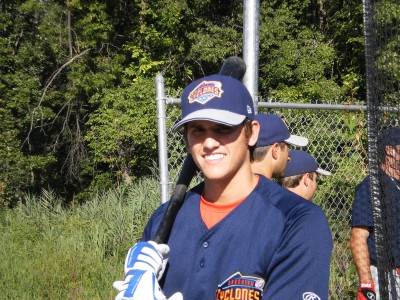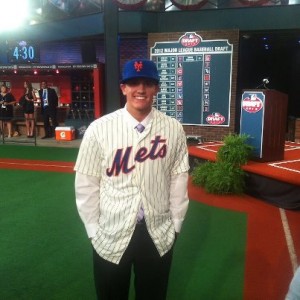Last draft day, I watched and waited to see who the Mets would select with their first round pick. I watched as my first choice, Carlos Correa was called Number One overall, and Addison Russell, my second choice was nabbed one spot before the Mets. When Bud Selig stepped up to the podium and finally announced the Mets’ selection, admittedly I, as well as many others, groaned as our newly minted top prospect, Gavin Cecchini, walked onto the stage to grab his jersey and hat.
Later that evening, as the first day of the draft was wrapping up, Tommy Tanous, the Mets’ director of amateur scouting, told us that Cecchini was someone the Mets had wanted all along.
“He is somebody we targeted all year,” said Tanous. “An offensive shortstop but he doesn’t give much away defensively.”
I’m not sure how accurate that may be, because it’s the usual clichè you hear quite often from team executives, especially scouting directors, every draft day.
Almost immediately, the voices in draft forums, the talking heads, and social media were abuzz with many already writing Cecchini off before he ever swung a bat in his new Mets uniform.
However, I did not write him off and instead began pouring over his many available scouting reports and other online information that was widely available to everyone. Eventually, I started to warm up to the Louisiana shortstop with the big smile. Summarizing the scouting reports, he is a high floor, mid ceiling type of prospect, with an advanced bat capable of a high average (possibly .280 – .290 with continued development), with the ability to spray drive line drives all over the field.
In terms of power, Matt Eddy from Baseball America projects him to hit up to 10 home runs annually, while MLB.com’s Jonathon Mayo rated his future power as a 4 on the 2-8 scale, which translates to 10-12 home runs annually. Either way, they project him to hit many doubles, which for a projected top of the order hitter, is great news.
As a defensive player, Baseball America called Cecchini a solid shortstop, rating his hands and footwork good enough to stick at the position. Mayo rates his fielding as a future 6, meaning plus. The only knocks that have been made against him on fielding is his arm, which rates average. Usually, most regular shortstops are rated plus. But either way, it looks as though scouts agree that Cecchini will be able to stick at his position despite the average arm strength.
Although these scouting reports don’t scream “future star”, they do show an above-average shortstop in the makings, possibly even top-10 if everything goes right, which as a fan, is something we all want.
Usually, the first round is known for selecting and signing high-ceiling talent, but a lower-ceiling advanced talent can sometimes work his way into the first round and surprise many.
To give a very recent example, in 2008, Ike Davis did not receive a glowing report and was considered a lower rated talent than Eric Hosmer, Justin Smoak, Yonder Alonso, and David Cooper. Unlike Smoak, Alonso, and Cooper, Davis became an above average first baseman and probably will be the first baseman of the Mets for years to come. Hosmer has become the Royal’s first baseman of the future, while Alonso, Smoak, and Cooper are still trying to find their way. Both Alonso and Smoak have already been traded, and Cooper is finally making it onto Toronto’s radar five years since being drafted.
Back to Cecchini. For those not excited by his bat, they should find a new context when it pertains to shortstops. As stated above, Cecchini’s ceiling is a shortstop who could hit .280 with 10-12 home runs annually with lots of doubles. I think I’ll stick with the most popular stats, average and home runs, because the greater majority of fans still relate to them as a means of judging players.
Batting Average:
Projected peak Batting Average for Gavin Cecchini: .280 – .290
In the majors last year, there were just eight shortstops in the Major Leagues with a batting average of .280 or better. This could mean that Cecchini could become a top eight shortstop in hitting for average if everything goes right and he meets most scouts’ expectations.

Home Runs:
Projected peak Home Runs for Gavin Cecchini: 10 – 12
Shortstops are not known for power. It is rare to find a shortstop that will annually hit more than 20 home runs. There were only 4 who hit 20 or more home runs. In fact, there were 13 Shortstops in the Majors last year who hit 10 or more home runs. If Cecchini can swing for the fences at least 10 times, that is still an above average shortstop.

First Season As A Pro:

Cecchini was signed almost immediately after the Draft and sent to Kingsport for 53 games. During that time, he hit .246 with 9 doubles, 2 triples, and 1 home run. He also stole 5 bases but was caught 4 times. To me, these stats are pretty good, especially for a newly drafted 18 year old competing in a league where the average age is 21 years old. It should be noted that Cecchini was cruising along at a .285 clip until he broke his finger, missed some time, and was clearly hindered by the injury for the rest of the season.
The bottom line is that Cecchini was playing a premium position in a league where the average player was three years ahead of him in development time. For a teenager, under the conditions he was asked to play in, Cecchini impressed me and held his own batting close to .250 in a league where he was clearly in over his head purely on an age standpoint. He will, however, have to improve on his base running.

Gavin Cecchini strikes a pose for MMO last summer after he was promoted to the Brooklyn Cyclones.
What The Future May Hold:
I am excited to see what Gavin Cecchini does for an encore this season, but I am realistic. It depends on where he ends up. He should begin the season exactly where he ended 2012 at Short Season Single-A Brooklyn. But if he impresses in STEP Camp, he could be pushed up to a full season league and go straight to Single-A Savannah. I see an average close to .265, with 5 home runs and 15-18 doubles if he winds up in Brooklyn.
In Savannah, a notorious pitcher’s park, I can see him hitting the same average but with 7 home runs and 20-25 doubles. Either way, that will be impressive and more than welcome, given that he will be one of the youngest players in his league once again.
Cecchini was selected within the top 15 picks of the 2012 draft, and for good reason. With at least above average fielding, an average arm, and potential for a high average and double digit home runs, Cecchini projects to be an above average shortstop, possibly a top ten shortstop if everything goes right.
If he improves his base running, all the more better. So, in summary, please do not write him off so quickly base on small sampling or because he wasn’t your first choice on draft day. He’s a Met now and we own him and all I’m trying to establish is that he might be a much better player than what most people think. We’ll have a much better idea of what we have here in 2-3 years and that will make him easier to accurately project. Do me favor… Keep an open mind and give Gavin Cecchini a chance to change your opinion of him.
What are the 5 Tools?
1. SPEED: Speed is the one tool you can’t teach. However it is possible to enhance a ballplayer’s speed, but substantial improvement is dependent upon each individual athlete and based on good jumps (burst) and reading situations.
2. ARM STRENGTH: While not as important as the other four tools it can be a formidable weapon on defense, and valuable in evaluating a pitcher’s muscle endurance and ability to throw hundreds of pitches weekly without sustaining injury.
3. HITTING FOR AVERAGE: Hitting for average requires the ability to hit to all fields and also identifying defensive situations as well. Making contact and bunting are all part of it.
4. HITTING FOR POWER: “Chicks did the longball”, isn’t that what Sandy Alderson always says? The benefits of power need no explaination.
5. FIELDING: Just as important as hitting for average or power and many a games’ outcome can boil down to one defensive play. Defense does matter.
Note from Joe D. – We want to welcome Teddy to MMO and look forward to his valued insights. It’s not often that we can get the perspective of someone who has a background in scouting and sees baseball prospects and minor leaguers differently than most of us do. Teddy was a scouting assistant for the DSL under Omar Minaya, spent time interning for the Cape Cod League, and also with the Brooklyn Cyclones for whom he developed, edited and produced scouting videos. Teddy’s father, Joe Klein is the widely respected and notable writer whose books books such as Primary Colors were New York Times Bestsellers and and that particular one eventually became a hit blockbuster Hollywood movie.

